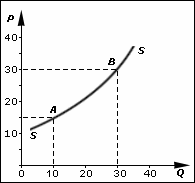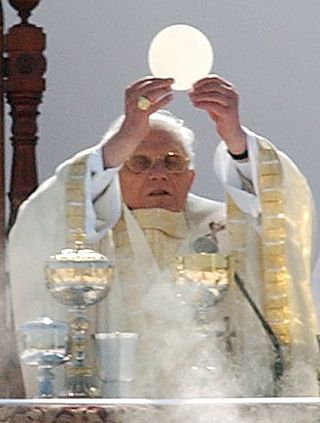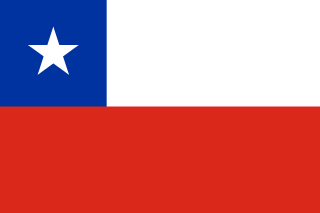
The Eucharist, also known as Holy Communion, Blessed Sacrament and the Lord's Supper, is a Christian rite that is considered a sacrament in most churches, and as an ordinance in others. Christians believe that the rite was instituted by Jesus at the Last Supper, the night before his crucifixion, giving his disciples bread and wine. Passages in the New Testament state that he commanded them to "do this in memory of me" while referring to the bread as "my body" and the cup of wine as "the blood of my covenant, which is poured out for many". According to the Synoptic Gospels this was at a Passover meal.

Transubstantiation is, according to the teaching of the Catholic Church, "the change of the whole substance of bread into the substance of the Body of Christ and of the whole substance of wine into the substance of the Blood of Christ". This change is brought about in the eucharistic prayer through the efficacy of the word of Christ and by the action of the Holy Spirit. However, "the outward characteristics of bread and wine, that is the 'eucharistic species', remain unaltered". In this teaching, the notions of "substance" and "transubstantiation" are not linked with any particular theory of metaphysics.

A demand curve is a graph depicting the inverse demand function, a relationship between the price of a certain commodity and the quantity of that commodity that is demanded at that price. Demand curves can be used either for the price-quantity relationship for an individual consumer, or for all consumers in a particular market.
Latvian cuisine typically consists of agricultural products, with meat featuring in most main meal dishes. Fish is commonly consumed due to Latvia's location on the eastern shore of the Baltic Sea.

Intinction is the Eucharistic practice of partly dipping the consecrated bread, or host, into the consecrated wine before consumption by the communicant.

Eucharistic theology is a branch of Christian theology which treats doctrines concerning the Holy Eucharist, also commonly known as the Lord's Supper. It exists exclusively in Christianity and related religions, as others generally do not contain a Eucharistic ceremony.
In economics, demand is the quantity of a good that consumers are willing and able to purchase at various prices during a given time. The relationship between price and quantity demand is also called the demand curve. Demand for a specific item is a function of an item's perceived necessity, price, perceived quality, convenience, available alternatives, purchasers' disposable income and tastes, and many other options.

In economics, supply is the amount of a resource that firms, producers, labourers, providers of financial assets, or other economic agents are willing and able to provide to the marketplace or to an individual. Supply can be in produced goods, labour time, raw materials, or any other scarce or valuable object. Supply is often plotted graphically as a supply curve, with the price per unit on the vertical axis and quantity supplied as a function of price on the horizontal axis. This reversal of the usual position of the dependent variable and the independent variable is an unfortunate but standard convention.

Blood of Christ, also known as the Most Precious Blood, in Christian theology refers to the physical blood actually shed by Jesus Christ primarily on the Cross, and the salvation which Christianity teaches was accomplished thereby, or the sacramental blood (wine) present in the Eucharist or Lord's Supper, which some Christian denominations believe to be the same blood of Christ shed on the Cross.

Eucharist is the name that Catholics give to the sacrament by which, according to their belief, the body and blood of Christ are present in the bread and wine that are consecrated during the Catholic eucharistic liturgy, generally known as the Mass. The definition of the Eucharist in the 1983 Code of Canon Law as the sacrament where Christ himself "is contained, offered, and received" points to the three aspects of the Eucharist according to Catholic theology: the real presence of Christ in the Eucharist, Holy Communion, and the holy sacrifice of the Mass.

Sacramental wine, Communion wine, altar wine, or wine for consecration is wine obtained from grapes and intended for use in celebration of the Eucharist. It is usually consumed after sacramental bread.

Sacramentum caritatis is the first post-synodal apostolic exhortation by Pope Benedict XVI. It was signed February 22, 2007.

Pinchitos or Pinchos Morunos is a Moorish-derived food in Spanish cuisine, similar to kebab. The name pinchitos is used in the southern Spanish autonomous communities of Andalusia and Extremadura. They consist of small cubes of meat threaded onto a skewer which are traditionally cooked over charcoal braziers.
Barm, also called ale yeast, is the foam or scum formed on the top of a fermenting liquid, such as beer, wine, or feedstock for spirits or industrial ethanol distillation. It is used to leaven bread, or set up fermentation in a new batch of liquor. Barm, as a leaven, has also been made from ground millet combined with must out of wine-tubs and is sometimes used in English baking as a synonym for a natural leaven (sourdough). Various cultures derived from barm, usually Saccharomyces cerevisiae, became ancestral to most forms of brewer's yeast and baker's yeast currently on the market.
Traditional Estonian cuisine has substantially been based on meat and potatoes, and on fish in coastal and lakeside areas, but now bears influence from many other cuisines, including a variety of international foods and dishes, with a number of contributions from the traditions of nearby countries. Scandinavian, German, Russian, Latvian, Lithuanian and other influences have played their part. The most typical foods in Estonia have been rye bread, pork, potatoes and dairy products. Estonian eating habits have historically been closely linked to the seasons. In terms of staples, Estonia belongs firmly to the beer, vodka, rye bread and pork "belt" of Europe.

Chilean cuisine stems mainly from the combination of traditional Spanish cuisine, Chilean Mapuche culture and local ingredients, with later important influences from other European cuisines, particularly from Germany, the United Kingdom and France. The food tradition and recipes in Chile are notable for the variety of flavours and ingredients, with the country's diverse geography and climate hosting a wide range of agricultural produce, fruits and vegetables. The long coastline and the peoples' relationship with the Pacific Ocean add an immense array of seafood to Chilean cuisine, with the country's waters home to unique species of fish, molluscs, crustaceans and algae, thanks to the oxygen-rich water carried in by the Humboldt Current. Chile is also one of the world's largest producers of wine and many Chilean recipes are enhanced and accompanied by local wines. The confection dulce de leche was invented in Chile and is one of the country's most notable contributions to world cuisine.
Free association, also known as free association of producers, is a relationship among individuals where there is no state, social class, hierarchy, or private ownership of means of production. Once private property is abolished, individuals are no longer deprived of access to means of production, thus enabling them to freely associate without social constraint to produce and reproduce their own conditions of existence and fulfill their individual and creative needs and desires. The term is used by anarchists and Marxists and is often considered a defining feature of a fully developed communist society.
Ancient Israelite cuisine refers to the culinary practices of the Israelites from the Late Bronze Age arrival of Israelites in the Land of Israel through to the mass expulsion of Jews from Roman Judea in the 2nd century CE. Dietary staples among the Israelites were bread, wine, and olive oil; also included were legumes, fruits and vegetables, dairy products, fish, and meat.

DeLaurenti Food & Wine is an Italian speciality grocery store and delicatessen at Seattle's Pike Place Market, in the U.S. state of Washington.









